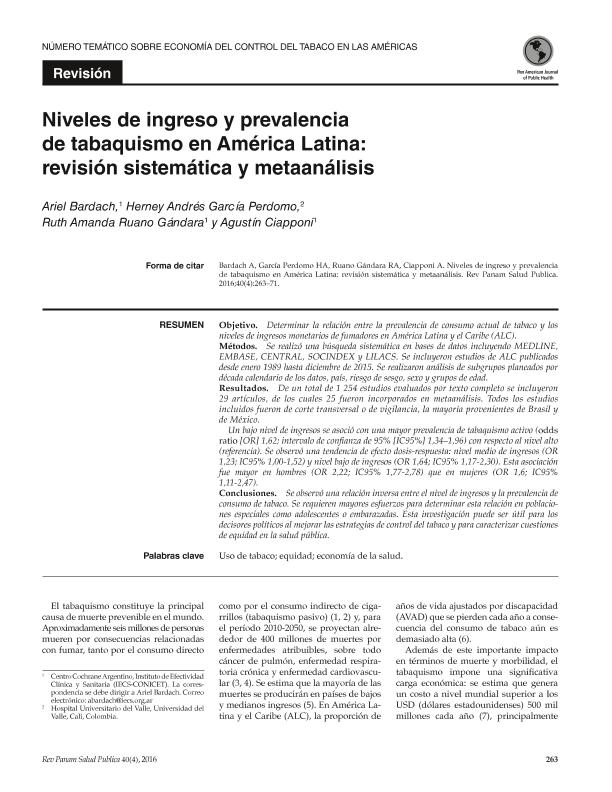Artículo
Objective. Determine the relationship between the prevalence of current tobacco use and smoker income levels in Latin America and the Caribbean (LAC). Methods. A systematic search was conducted in MEDLINE, EMBASE, CENTRAL, SOCINDEX, and LILACS databases. Studies from LAC published from January 1989 to December 2015 were included and analyzed by subgroups disaggregated by decade of data, country, bias risk, sex, and age group. Results. Of 1,254 studies evaluated by full text, 29 articles were included, of which 25 were chosen for meta-analysis. All included studies were cross-sectional or surveillance, and were primarily from Brazil and Mexico. Low income was associated with a higher prevalence of active tobacco use (odds ratio [OR] 1.62; 95% confidence interval [95% CI] 1.34–1.96 than high income (reference). A dose-response effect trend was observed: middle income (OR 1.23; 95% CI 1.00-1.52) and low income (OR 1.64; 95% CI 1.17-2.30). This association was greater in men (OR 2.22; 95% CI 1.77- 2.78) than in women (OR 1.6; 95% CI 1.11-2.47). Conclusions. An inverse relationship was observed between income and tobacco use prevalence. Further efforts are required to determine this relationship in special populations, such as adolescents and pregnant women. This research may be useful to policymakers by improving tobacco control strategies and characterizing public health equity issues. Objective
Determine the relationship between tobacco-use prevalence and smoker income level in Latin America and the Caribbean (LAC).
Methods
A systematic search was carried out in MEDLINE, EMBASE, CENTRAL, SOCINDEX, and LILACS databases. Studies from LAC published from January 1989 to December 2015 were included and were analyzed by subgroups disaggregated by decade of data, country, bias risk, sex, and age group.
Results
Of 1 254 studies evaluated by full text, 29 articles were included, of which 25 were chosen for meta-analysis. All included studies were cross-sectional or surveillance, primarily from Brazil and Mexico. Low income was associated with higher prevalence of active smoking (odds ratio [OR] 1.62; 95% confidence interval [95%CI] 1.34–1.96) than high income (reference). A dose-response effect trend was observed: middle income (OR 1.23; 95%CI 1.00-1.52) and low income (OR 1.64; 95%CI 1.17-2.30). This association was greater in men (OR 2.22; 95%CI 1.77-2.78) than in women (OR 1.6; 95%CI 1.11-2.47).
Conclusions
An inverse relationship was observed between income and tobacco-use prevalence. Further efforts are required to determine this relationship in special populations, such as adolescents and pregnant women. This research can be useful for policymakers by improving tobacco control strategies and for characterizing public health equity issues.
Niveles de ingreso y prevalencia de tabaquismo en América Latina: revisión sistemática y metaanálisis
Título:
Income and smoking prevalence in Latin America: a systematic review and meta-analysis
Bardach, Ariel Esteban ; García Perdomo, Herney Andrés; Ruano Gandara, Ruth Amanda; Ciapponi, Agustín
; García Perdomo, Herney Andrés; Ruano Gandara, Ruth Amanda; Ciapponi, Agustín
 ; García Perdomo, Herney Andrés; Ruano Gandara, Ruth Amanda; Ciapponi, Agustín
; García Perdomo, Herney Andrés; Ruano Gandara, Ruth Amanda; Ciapponi, Agustín
Fecha de publicación:
07/2016
Editorial:
Pan American Health Organization
Revista:
Revista Panamericana de Salud Pública
ISSN:
1020-4989
Idioma:
Español
Tipo de recurso:
Artículo publicado
Clasificación temática:
Resumen
Palabras clave:
Tabaquismo
,
América Latina
Archivos asociados
Licencia
Identificadores
Colecciones
Articulos(SEDE CENTRAL)
Articulos de SEDE CENTRAL
Articulos de SEDE CENTRAL
Citación
Bardach, Ariel Esteban; García Perdomo, Herney Andrés; Ruano Gandara, Ruth Amanda; Ciapponi, Agustín; Niveles de ingreso y prevalencia de tabaquismo en América Latina: revisión sistemática y metaanálisis; Pan American Health Organization; Revista Panamericana de Salud Pública; 40; 4; 7-2016; 263-271
Compartir



